Caring For Cashmere Clothes

The clothes in your collection made of cashmere undoubtedly hold a special place as pieces to be worn with a great deal of care and consideration. Often expensive, always luxurious - cashmere garments are a timeless cornerstone of fashion at its finest. This level of prestige calls for the very best practices in cleaning, storing and preserving these clothes.
Why is Cashmere a Luxury Textile
Cashmere has reigned supreme in the world of natural fiber textiles for thousands of years, and to think it’s spun from the fine undercoat of certain mountain goats seems plucked straight from a fairytale.
The process that takes the bushy winter fleece from around a goat’s neck to turn it into the luxuriant softness cashmere is known for is a time-consuming and meticulous task.
It begins in spring, when goats naturally shed their downy-soft double fleece that’s grown throughout winter to keep them warm. The undercoat can be shaved off or, preferably, combed through to release tufts of fleece to spin into skeins of yarn.
Once dyed, the yarn is woven into wearable textiles of all kinds, though scarves and sweaters made of cashmere tend to be the most commonly purchased garments.
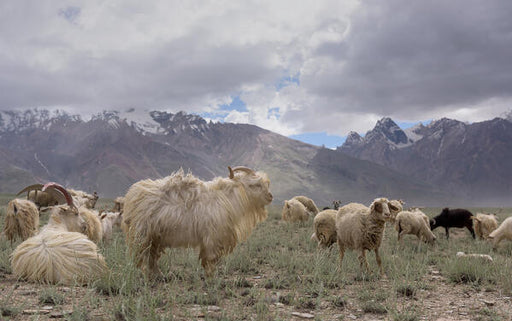
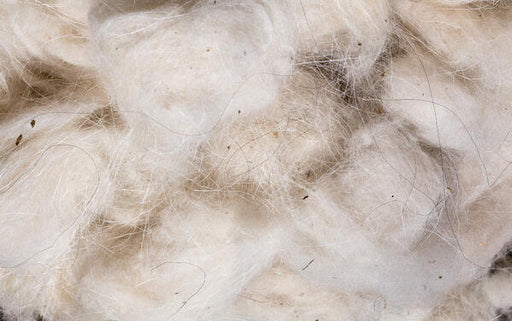
Naturally, the quality of the final garment is influenced by many factors.
While any goat can produce the winter undercoat used to make cashmere’s woolen yarn, specific breeds — now called cashmere or pashmina goats — are known for possessing the softest undercoats of any breed.
In particular, herds from the Kashmir Valley, hemmed to the northeast by the Himalayas, are believed to produce the finest cashmere wool due to the individual hairs of their undercoat being longer and smoother as a result of their environment.
Additionally, cashmere wool that has been collected by a comb-through method is often regarded as having a finer quality and softer feel than cashmere gathered from shorn goats. This is because the hand-picked process results in fewer of the coarse guard hairs that shearing cannot avoid so easily.
However, combing and de-hairing the soft fleece can take one to two weeks, which is considerably longer than less refined methods.
Knowing how much work is involved in the production of cashmere textiles, it’s easy to understand why just as much care must go into cleaning and keeping these valuable pieces pristine.
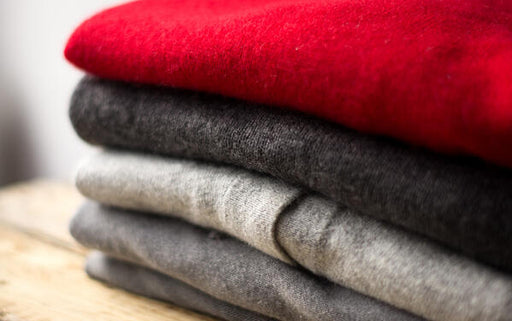
Dry Cleaning Guidelines for Cashmere Clothes
Dry cleaning is so-named due to the use of solvents, rather than soap and water, to clean garments.
When it comes to whether you should dry clean your cashmere or hand wash it at home, there are a few things to keep in mind.
First, you should consult the label on your garment. If it explicitly states that the item should not be dry cleaned, it’s wise to take it at its word. Dry cleaning solvents can be harsh on natural fibers like cashmere and cause a build-up that makes the piece look dull.
However, if your item has unsightly stains or if you’re worried about a clothes moth infestation, taking it to the dry cleaner may be your best option to restore the piece to its former glory.
For normal needs, dry cleaning should be done sparingly for cashmere, when appropriate.
To learn more on how to wash cashmere, check out our post.

Keeping Cashmere Garments Clean at Home
The process of cleaning a cashmere garment yourself properly is not difficult, but it does require taking your time with a few key steps and using the appropriate products.
Be sure to pre-treat any spots or stains with a cashmere-safe stain remover, then turn the garment inside out before washing it by hand or placing it into a washing machine.
Hand-washing Cashmere
Follow these steps for the best results when hand-washing cashmere, being especially careful with 100% cashmere garments:
- Choose a mild detergent that is labelled safe for use with cashmere garments.
- Fill a sink or tub with lukewarm water and the appropriate amount of detergent.
- Fully submerge the cashmere garment; agitate gently to move the soapy water through the clothing, but do not twist or rub the fabric.
- Allow the garment to soak for at least five minutes; soak longer if the garment is heavily soiled, but no more than 30 minutes should be needed.
- Rinse by running cool water over the garment until it runs clear.
- Avoid lifting the garment while sodden as this could stretch the fabric and cause it to become misshapen.
- To rid the clothing of excess water, squeeze it against the side of the tub or sink. Do not wring or twist the piece as this can damage the natural fibers of the wool.
Machine-washing Cashmere
- Only machine-wash cashmere if the label states it’s okay, which is more typical of cashmere blends than pure cashmere garments.
- Only use washing machines that allow you to adjust temperature and cycle settings.
- Use a mesh garment bag to reduce the chance of your garment snagging or stretching.
- Choose cashmere-safe detergents that can be used with machine washers.
- Water temperature should not exceed 40 degrees Celsius (104 degrees Fahrenheit).
- Set the cycle to delicates or, if the machine has it, woolens.
- Choose the gentlest spin cycle.

Drying Cashmere
Whether you choose to hand-wash or machine-wash your cashmere garments, special considerations need to be made when it comes to drying them.
Never tumble dry cashmere garments unless the label provides instructions on how to do so.
Natural fibers like cashmere are more vulnerable to damage and permanent stretching when wet, so extraordinary care should be taken while handling damp pieces. When drying a cashmere garment after washing, lay it out flat on a hard surface.
You can speed the drying process by placing a towel beneath the garment and another on top, then gently rolling the sandwiched garment into a spiral. The natural pressure this places on the garment will help squeeze the water out without causing the fabric to stretch.
De-wrinkling Cashmere
As with any part of the cleaning and drying process, consult your garment’s label for any warnings or instructions when it comes to ironing or steaming the cashmere piece. If ironing is listed as safe, it will certainly call for a low temperature setting.
You should also only iron a cashmere garment when it is turned inside out. This minimizes the risk of the iron leaving a visible mark or causing pilling or pulling of the fabric’s fibers. When possible, steaming cashmere to straighten wrinkles is preferred.
Stain and Spot Removal for Cashmere Clothing
Never use bleach or products that contain bleach when spot-removing on cashmere clothing. Even if the bleach product is color-safe or heavily diluted, the harsh chemicals can degrade the natural wool fibers.
Some cashmere and wool-safe detergents can act as a spot treatment, but only use them in this manner if the label specifies appropriate instructions on how to use it in this way. Typically, the stain removal process with a detergent means applying an undiluted or heavily concentrated amount directly to the stained area and leaving it to sit for a few minutes.
When in doubt, take the garment to a dry cleaning professional if you have an especially stubborn stain. They should be able to help you determine if their solvents are safe enough for spot-treating a cashmere garment even if it’s not suitable to use solvents for a full wash and press cycle.
Read more on cashmere stain removal.

Protecting Cashmere Garments Against Damage
Appropriate Wear
Textiles made from natural fibers like cashmere may be more likely to hold body oils and perspiration, which can cause yellowing and staining where it contacts the skin closely. The underarm area is particularly vulnerable to this kind of exposure.
Wearing thin, breathable clothing beneath your cashmere pieces, when possible, can help reduce its exposure to your natural oils.
Careful Handling of Cashmere
Mishandling is the number one reason cashmere garments become misshapen or ruined. If your garment has intricate beading or bright, colorful dye, you should always hand-wash it even if the label says machine washing or dry cleaning are safe.
This way, you can ensure you preserve every detail and keep your cashmere looking as good as new.
Use the Right Tools
Due to the short, natural fibers that make up cashmere wool, your garment may begin to pill in areas where it rubs together or as a reaction to washing and drying.
While this is normal for cashmere textiles, you’ll need to de-pill it carefully to avoid damaging the garment.
Invest in a specialty wool comb to help you manage this process safely.
Minimize Exposure
In between wear, try to keep your cashmere garments out of direct sources of light or heat.
Never store them near radiators, central air vents or windows. Both heat and light are the enemies of natural fabric clothing, especially cashmere.
Use Conditioner
Cashmere or wool-safe softeners and conditioners can help keep your cashmere garments feeling soft and supple. Even mild detergents can strip away the natural oils that protect the individual hairs within each woven strand of yarn.
Replenish them with safe, gentle conditioners specifically formulated for use with this delicate textile.
Preventing Clothing Moth Infestation with Cashmere Clothes
Clothes moths are a menace that, once established, can cause a significant amount of damage in a very short amount of time.
Clothing moth infestations are prone to occur when clothing is stored during the off-season, so warm summer months are prime time for clothing moths to dig in to popular winter wear like cashmere scarves and sweaters.
Clothes moths who feast on valuable garments like cashmere or silk are primarily attracted the proteins found from remnant body oils and skin cells shed during regular wear.
Cleaning cashmere clothing thoroughly before storing it is the first step in preventing a destructive infestation from taking hold of your closet.
Also, clothes moths thrive in dark, damp recesses, so make sure to bring your stored garments out occasionally, even when you have no intention of wearing them any time soon. Airing them out and exposing them to gentle, ambient light can help deter pests like cloth moths from burrowing in for the long haul.
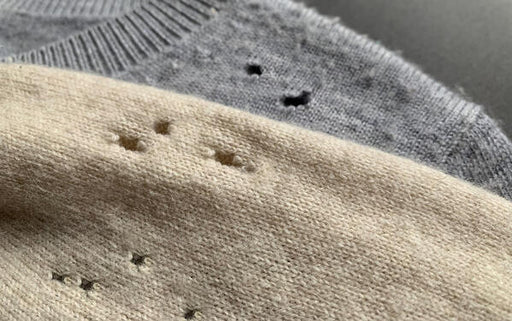
Investing in tried-and-true tricks of the trade may also help you keep your cashmere garments safe from pests.
Cedar oils are known to ward off clothing moths, as is lavender and cloves. While the oils in cedar can destroy eggs, they do not kill larvae or grown moths. Other natural remedies likewise deter, but do not destroy, eggs, larvae and adult moths.
Chemical-based fumigants and pesticides can be incredibly effective, but some people may need to avoid their use if they are sensitive to the smell or allergic to any ingredients. In this case, clothes moth traps are the perfect solution to controlling an infestation. These traps use non-toxic, naturally occurring pheromones to attract moths to the sticky strip that traps them to its surface permanently.
Whether you’ve just begun to see evidence of clothing moths attacking your cashmere or you’re dealing with a full-blown onslaught, it’s best to use multiple products that work to both repel and kill moths at all stages. Rewash your garments thoroughly and allow them to dry completely before storing them again after treating your space properly.
For more tips on clothes moths prevention, check our blog!
Tips for Storing Cashmere Garments
Simple steps like these will help you keep your cashmere in perfect condition so that it’s ready to be worn as soon as it’s brought back out again.
Before you pack your beloved cashmere items up for the season, you should prepare the area where they’ll be stored ahead of time. Give every inch of it a thorough dusting and disinfecting. Make sure it’s completely dry once you’re done wiping it all down.
Because cashmere clothing should never hang, you will need storage solutions that allow you to fold the garments neatly and keep them protected but still able to breathe. Choose handy storage options like a zip-up plastic bag that still allow for some airflow to keep condensation at bay.
As added protection, use an acid-free tissue paper between folded layers to reduce any possibility of pressure damage while in storage. Your storage space should also be out of direct light and heat, so choose a closet with a solid door and one that isn’t under a vent.
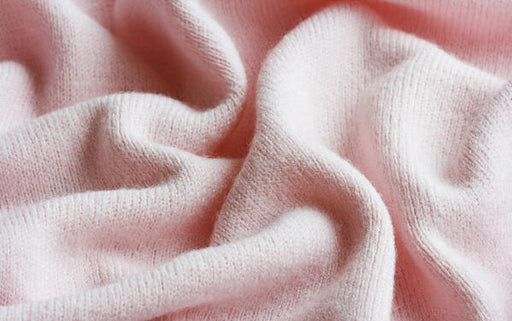
Remember to store your cashmere garments with natural moth repellents like cedar balls and lavender sachets. In order for these to remain effective, be sure to replenish them every month or two. Ideally, the closer the garments are to these deterrents, the more effective they will be, but avoid letting the fabric of your cashmere clothing touch cedar or lavender directly. A layer of tissue or cotton cloth should be sufficient to prevent the natural oils from seeping into the cashmere.
Finally, use pheromone clothes moth traps to attract and trap clothes moths. This also helps you monitor and remain vigilant of an emerging clothes moth problem in your cashmere. Be sure to place your moth deterrents away from your clothes moth traps for maximum effectiveness.
Cashmere Clothing Care
Taking care of your cashmere clothing may require a few extra steps and a small investment in the appropriate items necessary for cleaning and storing the items safely, but it’s well worth the time and effort when you know you’ll be able to keep your luxury items for years to come.
Don't forget to use clothes moth traps in your closet too - even when you don't have a moth problem. These clothes traps could prevent clothes moths from laying their eggs in your precious cashmere - find out more about our powerful pheromone clothes moth traps here - they're completely odorless and non-toxic, you won't even notice they're there.
FAQs for Caring For Cashmere Clothes
Now that you know where cashmere comes from, why it's such a luxurious textile option, and how to better care for your cashmere garments at home, let's go over some frequently asked questions about caring for and protecting your cashmere sweaters, tops, blazers, scarves, and so on.
How do you take care of cashmere clothes?
When caring for cashmere garments, you will want to take into consideration what material density you are working with. While all cashmere cloths are made from spun natural fibers, the makeup of garments can vary dramatically. A blazer, for instance, will usually be denser than a cashmere sweater. Dyes, mixed fabrics, leather accents, and other components of clothing must also be taken into consideration.
For example, caring for cashmere sweaters basically involves spot-treating any stains with cashmere-safe stain removers and then hand washing with cool water and cashmere-safe detergent. Carefully monitoring water temperature is important. Cashmere is a wool-like textile, so you must always use cool water to prevent shrinking or fiber damage.
Caring for cashmere blazer or suit jacket types of clothing may be a slightly different process. With these denser garments, shape, and styling matter more. You don’t want a blazer looking warped or misshapen, after all. If possible, spot-treat any stains (once again, with cashmere-safe stain removers) and target any areas that become soiled more easily. Avoid full water submersion if you can. Focus on treating soiled spots like the underarms, upper back, and cuffs. Then, hang the garment to dry. This will help it maintain its shape better than submerging it in water.
When caring for cashmere, always check the tags and labels to see if dry cleaning is recommended. With cashmere blazers and suits, dry cleaning is sometimes better than hand washing. However, this can vary from garment to garment, so use caution and common sense.
Is it OK to wash cashmere in the washing machine?
Cashmere can sometimes be machine-washed. Depending on the garment, you may be able to wash it using a gentle cold wool-safe cycle in your washing machine. Always check the tags and labels first to see what the manufacturer's recommendations are. After washing, hang your cashmere clothes to air dry. Never try to dry or remove moisture from cashmere using the heat of your clothes dryer. Heat like this can and will ruin cashmere clothes.
Usually, it is safer to hand-wash cashmere. This lets you closely monitor how the fabric is responding to water and the cleaning process. Use cashmere-safe detergents, cool water, and air dry when you are finished. You can read more about how to wash cashmere sweater materials by hand by scrolling to the middle of this article as well.
Is it better to wash or dry clean cashmere?
When caring for cashmere sweater materials, hand washing is usually the best option. This is because cashmere is soft and delicate. Sometimes, harsh dry-cleaning chemicals can damage the soft fibers of a cashmere sweater. Still, some cashmere garments are okay to dry clean. It all depends. This is why you must first check the labels on your clothes. Then, you can decide whether dry cleaning or hand washing is the best option for a particular item.
How do you keep cashmere in good condition?
There are a few things that you can do to keep your cashmere clothes in the best condition for as long as possible.
First of all, don't underestimate the power of safe storage. Cashmere is susceptible to fading, heat damage, moisture damage, and moth damage. Always store your cashmere clothing in a place that is safe from the elements and moths. Delicate cashmere sweaters, for instance, fare better when folded and stored between layers of acid-free tissue paper in air-tight containers such as large plastic totes. If you need to hang a cashmere garment, consider using a garment bag for protection. Keep your cashmere clothes out of direct sunlight to prevent fading.
Storing your cashmere clothing in cedar chests, on cedar shelves, or in a cedar-lined wardrobe may also be wise. Cedar naturally deters moths and smells great. Placing moth-deterrent sachets with rosemary, thyme, mint, and lavender near your cashmere garments is also a smart move.
Apart from proper storage, you must also know how to wash and care for cashmere clothes. Cashmere is a delicate, sensitive material that can be damaged by extreme temperatures or harsh cleaning methods.
- Always wash cashmere clothes with cool water only.
- Do not dry cashmere using heat as with a clothes dryer.
- Spot-treat cashmere clothes when you can.
- If possible, avoid total water submersion.
- If you must totally soak a garment, use cool water only.
- Rinse all cashmere garments with cold water.
- Remember to only use wool and cashmere-safe cleaning solutions, detergents, and stain removers.
- Hang your cashmere clothes to air dry indoors, do not use heat.
- Once completely dry, store cashmere clothes appropriately.
- Implement moth-safe cashmere storage solutions.
Why do moths eat cashmere?
The larvae of Clothes Moths thrive by consuming animal based fibers. Cashmere comes from the soft wooly undercoat of mountain goats. As such, it is a 100% natural fiber material with plenty of a protein called keratin. Since Clothes Moth larvae consume keratin, they will happily munch on your cashmere sweaters, blazers, blouses, and scarves. To prevent this from happening, always implement moth-proof storage methods for your favorite cashmere, wool, leather, and silk clothes.
About MothPrevention
MothPrevention® speak to customers every day about their clothes moth issues - clothes moths are a species that are ever increasing and that can cause significant damage to clothes, carpets and other home textiles.
To date, we’ve helped over 250,000 customers deal with their moth problems. We have developed professional grade solutions including proprietary pheromones and trap design, not available from anybody else in the USA.





